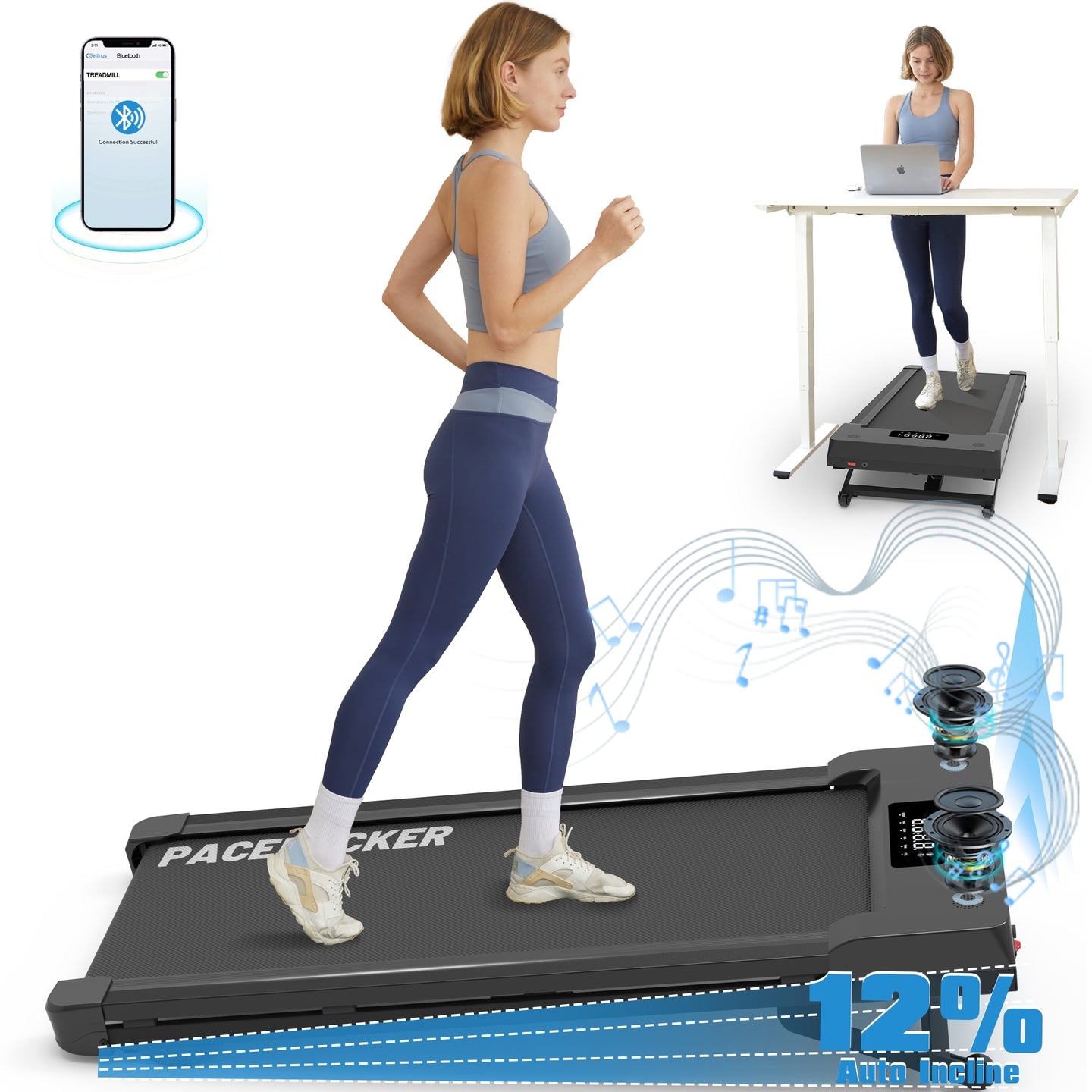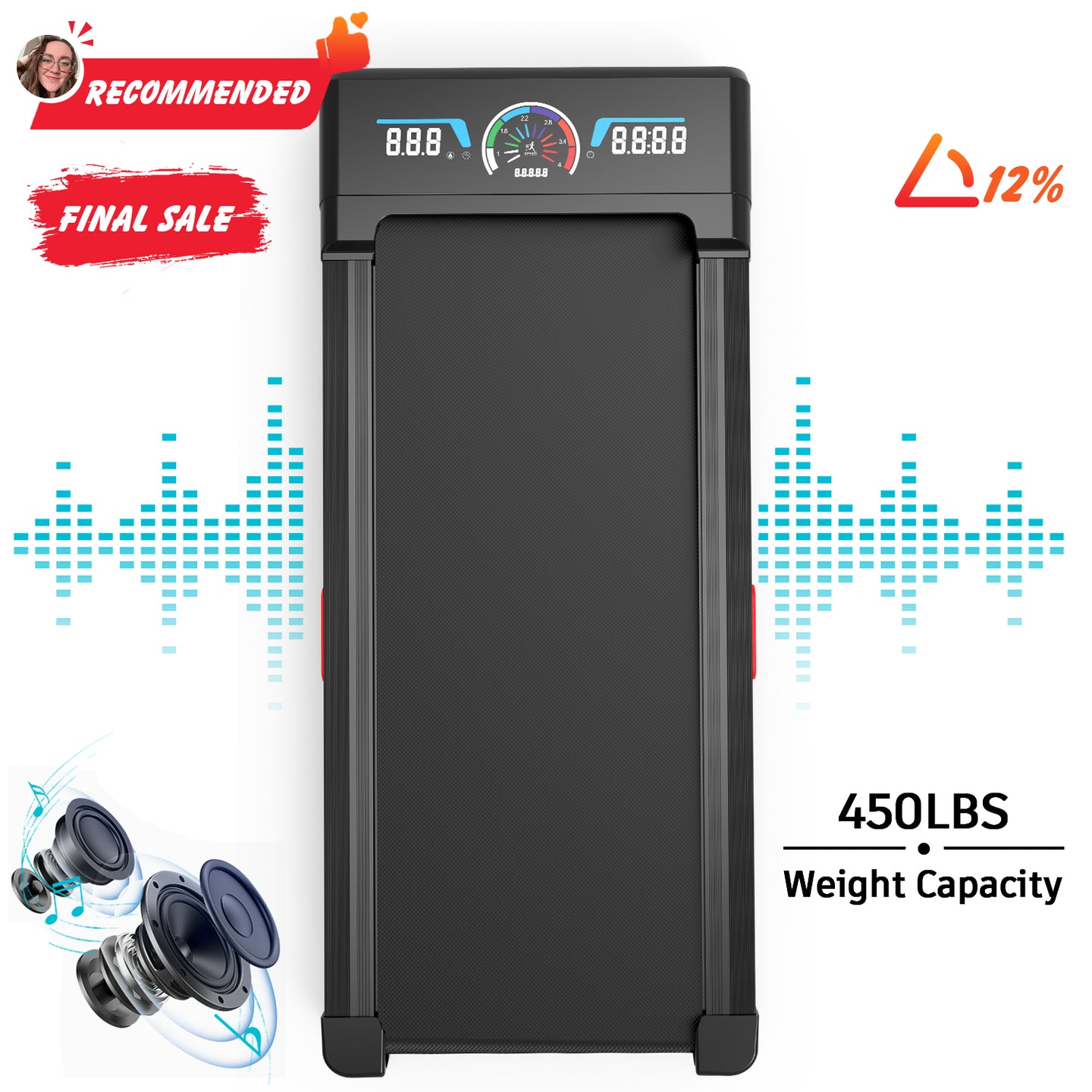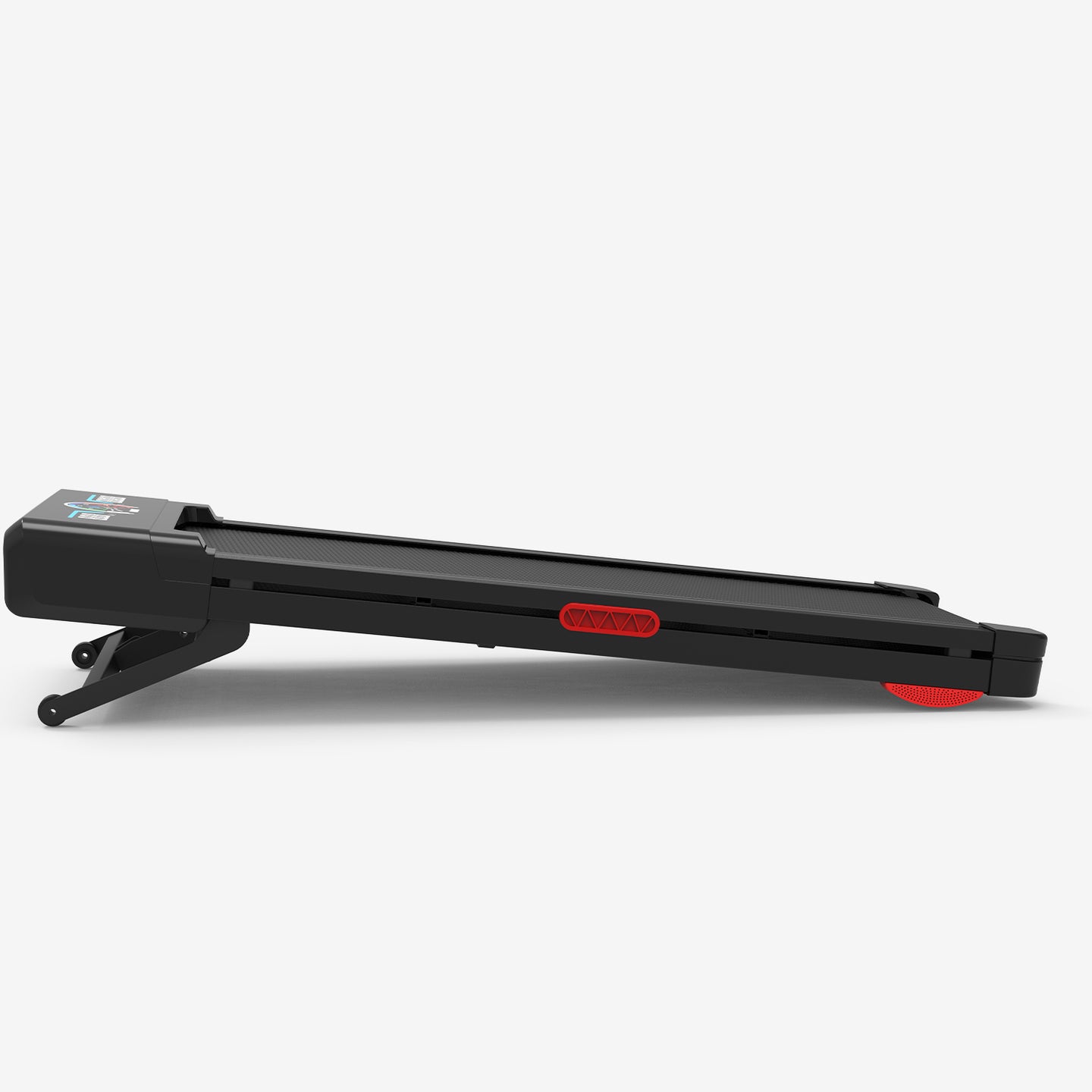Does Treadmill Burn Fat

Don’t forget to check out our Pacerocker, Trailviber, and Trailviber Auto Incline walking pad treadmills.
Treadmills have become a common sight in gyms and homes alike. They offer a straightforward way to engage in physical activity, rain or shine.
When we walk, jog, or run on a treadmill, we burn calories, which helps reduce body fat. Various treadmill workouts can boost our efforts, such as interval training or steady-state cardio. These options let us tailor the workout to our fitness level, keeping it both challenging and fun.
Along with using a treadmill, combining it with a healthy lifestyle can speed up the fat-burning process. Eating balanced meals, getting enough sleep, and staying hydrated are key factors. Let's explore how to make the most of treadmill workouts and fit this into our daily routines.
Key Takeaways
- Treadmills help burn calories and reduce body fat.
- Different treadmill workouts can enhance fitness and weight loss.
- A healthy lifestyle boosts treadmill workout results.
Understanding Treadmills and Weight Loss
Using a treadmill can be a great way to burn fat and lose weight by increasing calorie burn and boosting metabolism.
Benefits of Using a Treadmill
Treadmills provide a controlled environment to work out any time, regardless of the weather. We can adjust the speed and incline to mimic different terrains. This helps us customize our workout to suit our fitness level.
Regular use can strengthen our cardiovascular system. It improves endurance and promotes heart health. Walking or running on a treadmill can also increase muscle tone in the legs.
Treadmills often come with features like tracking heart rate, monitoring calorie burn, and virtual trails. These tools help in achieving weight loss goals and keeping track of progress. Plus, they provide a low-impact option for those with joint issues.
How Treadmills Aid in Fat Burning
When we use a treadmill, our body burns calories. The more intense the workout, the more calories we burn. This process helps in reducing fat over time. Interval training, which involves alternating high and low-intensity workouts, is especially effective in boosting fat loss.
Running at higher speeds or using incline increases the workload. It raises our heart rate and maximizes calorie burn. This intense activity accelerates the metabolism. A higher metabolism means burning calories even after the workout.
Consistent workouts on a treadmill can lead to a steady reduction in body fat. By combining treadmill sessions with a healthy diet, we can effectively work towards our weight loss goals.
Types of Treadmill Workouts
We can mix up our treadmill routine by walking, jogging, or running. These workouts can help burn fat effectively and improve cardiovascular health. Adding inclines or high-intensity intervals can make our workouts more challenging and engaging.
Walking on a Treadmill
Walking on a treadmill is a great way for us to start. It's low-impact and gentle on the joints. We can adjust the speed to fit our fitness levels, making it suitable for beginners. When we engage in steady-state cardio like walking, it helps in burning calories, which over time, contributes to fat loss.
Aiming for a brisk pace? We should try between 3 to 4 mph. This pace can help keep our heart rate elevated and maximize benefits. To make it more interesting, we can listen to podcasts or music. Walking workouts are perfect for consistent daily exercise.
Jogging and Running
Jogging and running on the treadmill can quickly elevate our heart rates. Both are high-impact activities that strengthen our cardiovascular system. Jogging is generally between 4 to 6 mph, a comfortable pace for longer durations. Running faster than 6 mph amps up the intensity for us.
Short bursts of running followed by jogging can boost the fat-burning process. Adapting this method can push our physical limits and improve endurance. We should ensure to wear proper shoes to avoid injuries. Staying hydrated and warmed up before running will keep us going strong.
HIIT on Treadmill
High-Intensity Interval Training (HIIT) on a treadmill is effective for burning fat in less time. We alternate between sprinting at full speed and walking or jogging. For example, sprinting for 30 seconds and then walking for a minute.
This method pushes our heart rate into the fat-burning zone. Because of its intensity, the body continues burning calories even after the workout ends. HIIT sessions are usually shorter, around 20-30 minutes, but highly effective. Let's ensure we're well-prepared before diving into HIIT.
Incline Treadmill Training
Treadmill workouts can be taken to the next level by simply adjusting the incline. Incline walking or running mimics uphill terrain. It increases the intensity and challenges our muscles more than flat walking. We can start at a 2% incline and gradually work our way up.
This workout targets not just the legs but the core as well, improving balance and strength. We burn more calories due to increased effort. It’s important to pay attention to our posture, keeping a straight back to avoid strain. Incline training adds variety and provides a new challenge for us.
Optimizing Your Workout Routine
To burn fat effectively on a treadmill, we can adjust our workouts to be more efficient. By setting a good pace, adding intervals, and mixing in strength exercises, we help our bodies target belly fat and build lean muscle mass.
Setting the Right Pace
Finding the right pace for our treadmill workouts is crucial. A moderate pace is ideal for starting out, allowing us to maintain a steady, sustainable effort. We aim for a speed that elevates our heart rate without leaving us breathless. Tracking our fitness level helps as we progress, letting us increase intensity over time. This consistency helps improve endurance while also burning calories effectively.
Going beyond just walking or jogging can involve adjusting the incline. Raising the treadmill incline simulates uphill movement, which engages the core muscles more and can enhance our workouts further. Remember to listen to our bodies and adjust as needed, ensuring safety and effectiveness.
Incorporating Interval Training
Interval training can boost our treadmill sessions significantly. This technique involves alternating between high-intensity bursts and periods of lower-intensity recovery. For example, we might sprint for one minute followed by two minutes of walking or light jogging. This method not only increases calorie burn but can also target belly fat more effectively than steady-paced exercises alone.
Intervals can be adapted to match our fitness level. Beginners can start with shorter sprints and longer recovery periods, while more experienced individuals can increase the intensity and duration of sprints. Consistently incorporating interval sessions into our routine challenges our bodies and stimulates greater fat loss.
Strength Training and Cardio Mix
Combining treadmill workouts with strength movements is a great way to build lean muscle mass. Engaging in a mix of strength training and cardio helps us burn more calories, even at rest. Exercises like lunges, squats, or light weight lifting can be included before, during, or after our treadmill workouts to enhance results.
Focusing on major muscle groups, including core muscles, boosts overall fat-burning potential. This blend of exercise strengthens the body and improves posture while helping to achieve a balanced fitness routine. By integrating both kinds of exercises, we create a comprehensive program that addresses both fat loss and muscle gain objectives.
Maximizing Fat Loss
When it comes to shedding fat, it's important to focus on strategies that burn calories and target body fat. Effective methods involve creating a calorie deficit, improving cardiovascular health, and addressing belly fat.
Creating a Calorie Deficit
To lose fat, we need to burn more calories than we eat. This is called a calorie deficit. It's the key to weight loss. By watching our daily intake and making smart food choices, we can achieve this.
Tracking what we eat helps us stay on target. Apps and journals can be useful here. Combining this with regular exercise will increase our calorie burn. Even simple activities like walking extra steps or taking the stairs add up. Small changes lead to significant results.
Cardiovascular Health and Fat Loss
Cardio exercises like running, cycling, and walking help with fat burning. They increase our heart rate and boost metabolism. This means more calories burnt throughout the day.
By doing aerobic exercises regularly, we not only burn fat but also enhance our overall wellness. Our heart becomes stronger, and our body becomes more efficient at using energy. Cardio sessions, mixed with strength training, optimize our fat loss journey. Consistent effort is key to burning calories effectively.
Targeting Deep-Tissue Abdominal Fat
Losing belly fat isn't just about looks. It's important for our health too. Deep-tissue abdominal fat links closely to health risks. Reducing it requires some focus.
Diet plays a critical role. Eating whole foods and avoiding sugar aids in losing belly fat. Engaging in core exercises strengthens the muscles around this area. Planks, sit-ups, and leg raises are great choices. Targeted exercises and a healthy diet make a noticeable impact on belly fat.
Tracking Progress and Health Metrics
When it comes to losing weight with a treadmill, it's important to keep an eye on certain health metrics. Monitoring our heart rate and metabolic rate can help us make the most of our workouts and ensure we're on the right track.
Using a Heart Rate Monitor
A heart rate monitor is a handy tool for tracking how hard we’re working during treadmill workouts. It shows us our heartbeats per minute. This helps us find and maintain our target heart rate, which is usually between 50% and 85% of our maximum heart rate.
Calculating our maximum heart rate is simple: subtract our age from 220. By staying in our target zone, we can build endurance and burn fat effectively. Seeing the data helps us adjust our effort to avoid overexertion. This makes our workouts safer and more productive, especially when aiming for treadmill weight loss.
Understanding Metabolic Rate
Our metabolic rate is vital to understanding how many calories we burn every day. Basal Metabolic Rate (BMR) measures how much energy our body needs at rest. Exercise increases this rate, helping us burn more calories, even after we've stepped off the treadmill.
We can boost our metabolic rate through regular treadmill workouts. As our fitness improves, our body becomes more efficient at using energy. This means we can lose weight more effectively over time. Tracking our metabolic rate also helps us understand how our habits affect calorie burning, ensuring we're making healthy choices to support our fitness goals.
Lifestyle Considerations for Enhanced Fat Loss
To effectively burn fat, we need to consider how our nutrition, cardio exercises, and varied workouts contribute to fat loss. By combining these elements, we can create a balanced lifestyle that aids our goals.
Nutritional Strategies
Eating a healthy diet is vital for fat loss. We should focus on foods that are high in protein while low in processed sugars. Proteins help build muscle, which can increase our metabolic rate.
Let's also look at portions. Smaller, more frequent meals can keep our metabolism active throughout the day. Hydration is another key player. Drinking enough water helps in digestion and can even reduce unnecessary snacking.
It’s crucial to limit alcohol intake as it can add empty calories and slow metabolism. Instead, choosing nutrient-dense foods like fruits, vegetables, and whole grains can provide us with the energy needed for effective exercise.
The Role of Regular Cardio
Regular cardio workouts are excellent for burning calories. Activities like aerobic exercise raise our heart rate and promote fat burning. 30 minutes of cardio, such as walking, running, or cycling, can significantly increase our daily calorie expenditure.
Consistency is key. Engaging in cardio most days of the week enhances our cardiovascular fitness and aids fat loss. If we enjoy our workouts, we're more likely to stick with them.
Interval training adds intensity, alternating between high and low effort periods, boosting fat burning. It can be as simple as sprinting for a minute, then walking for two.
Incorporating Other Forms of Exercise
While cardio is crucial, it’s beneficial to include different types of workouts. Strength training helps build muscle, which burns more calories while resting.
Incorporating yoga can also improve flexibility and reduce stress, which is beneficial for overall health. Conditioning exercises like circuit workouts can keep our routines dynamic.
Mixing these activities helps prevent boredom and keeps our bodies challenged. This mix supports sustained fat loss and cultivates a well-rounded exercise regimen that targets multiple areas of fitness, ensuring our workouts are more effective and enjoyable.
Working with Professionals
Partnering with a professional can supercharge our treadmill workouts. They help us optimize techniques and personalize routines, making them more effective for burning fat and gaining muscle mass.
Advice from a Personal Trainer
A personal trainer can offer valuable guidance on treadmill techniques. They can help us set the right pace, ensuring that whether we’re running or walking, we stay within optimal fat-burning zones.
For those interested in high-intensity interval training (HIIT), trainers can demonstrate how to incorporate these into treadmill workouts. HIIT workouts involve short bursts of intense running followed by brisk walking. This approach can maximize our calorie burn and maintain muscle mass. Meeting regularly with a trainer keeps us motivated and ensures correct form, reducing the risk of injury.
Tailoring a Fitness Plan
Creating a personalized fitness plan with a trainer ensures we hit our goals. They consider our fitness level and lifestyle, crafting a balanced routine. Whether it’s brisk walking or running, the plan emphasizes consistency and progression.
HIIT can be integrated once we build endurance, offering variety and challenge. Trainers adjust the treadmill's incline and speed according to our ability. They can also factor in off-treadmill exercises to enhance muscle mass and encourage fat loss. Personalization helps address our unique needs and keeps us engaged in the journey to better health.
Frequently Asked Questions
Using a treadmill can be a simple and efficient way to burn fat if done right. We’ll look into effective workouts, session lengths, speeds, and results.
What is an effective treadmill workout for fat loss?
Intervals can boost fat burning. Alternating between high-intensity sprints and slower walks works well. For example, try 30 seconds of sprinting followed by one minute of walking.
How long should I walk on the treadmill to see weight loss results?
Walking for 30 to 60 minutes most days of the week is ideal for weight loss. It allows us to burn calories consistently. Keep a steady pace for the best results.
Can regular treadmill exercise reduce belly fat?
Yes, with consistent effort, regular treadmill exercise can help reduce belly fat. Pair it with a balanced diet for faster results. Engaging the core while running can also be beneficial.
What speed should I set on the treadmill to maximize fat burning?
Walking briskly at about 3-4 mph or running at 5-7 mph can maximize fat burning. Adjust based on fitness level. It's important to find a challenging but sustainable pace.
How much weight is it possible to lose by using a treadmill regularly for two weeks?
Weight loss varies by person. Many experience weight loss of 1-2 pounds per week by combining regular treadmill exercise with a healthy diet. Monitor progress and adjust accordingly.
Are 30-minute treadmill sessions sufficient for losing weight effectively?
Yes, a 30-minute session can be effective. Even short, intense workouts like interval training can burn fat.
Discover how treadmill workouts help burn fat and which exercises enhance weight loss effectively. Combine healthy lifestyle choices for best results.







